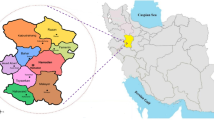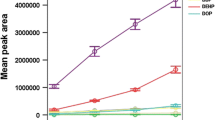Abstract
The objective of the present study was to investigate the level of 16 PAHs in fruit juice samples (orange, apple, peach, pineapple, and mango) with three different packages (PET bottle, Tetra Pak, and canned packaging) by using MSPE/GC–MS (magnetic solid-phase extraction and gas chromatography–mass spectrometry) method. In this method limit of detection (LOD), and limit of quantitation (LOQ), and recovery were 0.030–0.280 μg/L, 0.090–0.840 μg/L, and 94.8–102%, respectively. Our results showed the median of total PAHs and PAH4 (in all samples) were 7.67 ± 3.19 and 0.370 ± 0.160 μg/L, respectively. The median of BaP in samples was )0.060 ± 0.030 μg/L( lower than the standard level (0.200 μg/L in drinking water) of US Environmental Protection Agency (USEPA). Also, our results showed that pineapple juice had a maximum median of total PAHs of 12.4 ± 4.84 μg/L and mango juice had a minimum median of total PAHs of 5.17 ± 1.24 μg/L. Additionally, canned packaging had a maximum average total PAHs of 10.6 ± 5.22 μg/L and PET bottles had a minimum average total PAH of 5.25 ± 2.03 μg/L. A heat map approach was also used to cluster samples. The Monte Carlo results indicated that the estimated daily intake (EDI) rank order was Na > B(g)P > Ch > I(cd)P > B(b)F > Ph > B(k)F > F > Ace > Fl > B(a)P > B(a)A > P >A. The Monte Carlo simulation (MCS) results showed the incremental lifetime cancer risk (ILCR) at the 95th percentiles for adults and children was 4.91 × 10−7 and 9.12 × 10−7, respectively. It is concluded that the concentration of PAHs compounds in Iranian fruit juices is lower than the existing standards, and in terms of the risk of carcinogenesis, it does not threaten the human health (< 10−6).



Similar content being viewed by others
Availability of data and materials
All data generated or analyzed during current study are included in this article. The datasets analyzed during this study are available from the corresponding author on reasonable request.
References
Abou-Arab A, Abou-Donia M, El-Dars F, Ali O, Hossam A (2014) Levels of polycyclic aromatic hydrocarbons (PAHS) in some Egyptian vegetables and fruits and their influences by some treatments. Int J Curr Microbiol App Sci 3:277–293
Ambade B, Sethi SS (2021) Health risk assessment and characterization of polycyclic aromatic hydrocarbon from the hydrosphere. J Hazard Toxic Radioact Waste 25:05020008. https://doi.org/10.1061/(ASCE)HZ.2153-5515.0000586
Ambade B, Sankar TK, Kumar A, Sethi SS (2020) Characterization of PAHs and n-alkanes in atmospheric aerosol of Jamshedpur City, India. J Hazard Toxic Radioact Waste 24:04020003. https://doi.org/10.1061/(ASCE)HZ.2153-5515.0000490
Ambade B, Sethi SS, Kumar A, Sankar TK, Kurwadkar S (2021b) Health risk assessment, composition, and distribution of polycyclic aromatic hydrocarbons (PAHs) in drinking water of southern Jharkhand, East India. Arch Environ Contam Toxicol 80:120–133. https://doi.org/10.1007/s00244-020-00779-y
Ambade B, Kumar A, Sahu LK (2021a) Characterization and health risk assessment of particulate bound polycyclic aromatic hydrocarbons (PAHs) in indoor and outdoor atmosphere of Central East India. Environ Sci Pollut Res 28:56269–56280. https://doi.org/10.1007/s11356-021-14606-x
Ambade B, Kumar A, Kumar A, Sahu LK (2022a) Temporal variability of atmospheric particulate-bound polycyclic aromatic hydrocarbons (PAHs) over central east India: sources and carcinogenic risk assessment. Air Qual Atmos Health 15:115–130. https://doi.org/10.1007/s11869-021-01089-5
Ambade B, Sethi SS, Chintalacheruvu MR (2022b) Distribution, risk assessment, and source apportionment of polycyclic aromatic hydrocarbons (PAHs) using positive matrix factorization (PMF) in urban soils of East India. Environ Geochem Health 1-15. https://doi.org/10.1007/s10653-022-01223-x
Ambade B, Sethi SS, Giri B, Biswas JK, Bauddh K (2022c) Characterization, behavior, and risk assessment of polycyclic aromatic hydrocarbons (PAHs) in the estuary sediments. Bull Environ Contam Toxicol 108:243–252. https://doi.org/10.1007/s00128-021-03393-3
Aygun SF, Bagcevan B (2019) Determination of polycyclic aromatic hydrocarbons (PAHs) in drinking water of Samsun and it’s surrounding areas, Turkey. J Environ Health Sci Eng 17:1205–1212. https://doi.org/10.1007/s40201-019-00436-0
Camargo MCR, Toledo MCF (2003) Polycyclic aromatic hydrocarbons in Brazilian vegetables and fruits. Food Control 14:49–53. https://doi.org/10.1016/S0956-7135(02)00052-X
Di Bella C, Traina A, Giosuè C, Carpintieri D, Dico GML, Bellante A, Del Core M, Falco F, Gherardi S, Uccello MM (2020) Heavy metals and pahs in meat, milk, and seafood from augusta area (Southern Italy): contamination levels, dietary intake, and human exposure assessment. Front Public Health 8:273. https://doi.org/10.3389/fpubh.2020.00273
Ding C, Ni H-G, Zeng H (2013) Human exposure to parent and halogenated polycyclic aromatic hydrocarbons via food consumption in Shenzhen, China. Sci Total Environ 443:857–863. https://doi.org/10.1016/j.scitotenv.2012.11.018
Gorji MEH, Ahmadkhaniha R, Moazzen M, Yunesian M, Azari A, Rastkari N (2016) Polycyclic aromatic hydrocarbons in Iranian Kebabs. Food Control 60:57–63. https://doi.org/10.1016/j.foodcont.2015.07.022
Güler C (2007) Evaluation of maximum contaminant levels in Turkish bottled drinking waters utilizing parameters reported on manufacturer’s labeling and government-issued production licenses. J Food Compos Anal 20:262–272. https://doi.org/10.1016/j.jfca.2006.10.005
Hasan F, Alam N, Salam M, Rahman H, Paul S, Rak A, Ambade B, Islam A (2021) Health risk and water quality assessment of surface water in an urban river of Bangladesh. Sustain 13:6832. https://doi.org/10.3390/su13126832
Jafarabadi AR, Mashjoor S, Bakhtiari AR, Jadot C (2020) Dietary intake of polycyclic aromatic hydrocarbons (PAHs) from coral reef fish in the Persian Gulf—Human health risk assessment. Food Chem 329:127035. https://doi.org/10.1016/j.foodchem.2020.127035
Kafilzadeh F, Shiva AH, Malekpour R (2011) Determination of polycyclic aromatic hydrocarbons (PAHs) in water and sediments of the Kor River, Iran. Middle East. J Sci Res 10:01–07
Karimi F, Shariatifar N, Rezaei M, Alikord M, Arabameri M (2021) Quantitative measurement of toxic metals and assessment of health risk in agricultural products food from Markazi Province of Iran. Int J Food Contam 8:1–7. https://doi.org/10.1186/s40550-021-00083-0
Khalili F, Shariatifar N, Dehghani MH, Yaghmaeian K, Nodehi RN, Yaseri M (2021) The analysis and probabilistic health risk assessment of PAHs in vegetables and fruits samples marketed Tehran Chemometric. Glob Nest J 23:497–508. https://doi.org/10.30955/gnj.003734
Kiani A, Shariatifar N, Shahsavari S, Ahmadloo M, Moazzen M (2019) Investigating the presence of polycyclic aromatic hydrocarbons in Doogh. J Maz Univ Med Sci 29:10–23
Kiani A, Ahmadloo M, Moazzen M, Shariatifar N, Shahsavari S, Arabameri M, Hasani MM, Azari A, Abdel-Wahhab MA (2021) Monitoring of polycyclic aromatic hydrocarbons and probabilistic health risk assessment in yogurt and butter in Iran. Food Sci Nutr 9:2114–2128. https://doi.org/10.1002/fsn3.2180
Kim H-Y, Chung S-Y, Sho Y-S, Park S-S, Lee E-J, Suh J-H, Lee Y-D, Choi W-J, Kim J-S, Eom J-Y (2005) Concentration of polycyclic aromatic hydrocarbons in cereals, pulses, potatoes, and their products. Korean J Food Sci Technol 37:537–541
Kouhpayeh A, Moazzen M, Jahed Khaniki GR, Dobaradaran S, Shariatifar N, Ahmadloo M, Azari A, Nazmara S, Kiani A, Salari M (2017) Extraction and determination of phthalate esters (PAEs) in Doogh. J Maz Univ Med Sci 26:257–267
Lee J, Jeong J-H, Park S, Lee K-G (2018) Monitoring and risk assessment of polycyclic aromatic hydrocarbons (PAHs) in processed foods and their raw materials. Food Control 92:286–292. https://doi.org/10.1016/j.foodcont.2018.05.012
Lee Y-N, Lee S, Kim J-S, Patra JK, Shin H-S (2019) Chemical analysis techniques and investigation of polycyclic aromatic hydrocarbons in fruit, vegetables and meats and their products. Food Chem 277:156–161. https://doi.org/10.1016/j.foodchem.2018.10.114
Martorell I, Perelló G, Martí-Cid R, Castell V, Llobet JM, Domingo JL (2010) Polycyclic aromatic hydrocarbons (PAH) in foods and estimated PAH intake by the population of Catalonia, Spain: temporal trend. Environ Int 36:424–432. https://doi.org/10.1016/j.envint.2010.03.003
Moazzen M, Ahmadkhaniha R, Gorji ME, Yunesian M, Rastkari N (2013) Magnetic solid-phase extraction based on magnetic multi-walled carbon nanotubes for the determination of polycyclic aromatic hydrocarbons in grilled meat samples. Talanta 115:957–965. https://doi.org/10.1016/j.talanta.2013.07.005
Nazir NAM, Raoov M, Mohamad S (2020) Spent tea leaves as an adsorbent for micro-solid-phase extraction of polycyclic aromatic hydrocarbons (PAHs) from water and food samples prior to GC-FID analysis. Microchem J 159:105581. https://doi.org/10.1016/j.microc.2020.105581
Nie J, Shi J, Duan X, Wang B, Huang N, Zhao X (2014) Health risk assessment of dietary exposure to polycyclic aromatic hydrocarbons in Taiyuan, China. Res J Environ Sci 26:432–439. https://doi.org/10.1016/S1001-0742(13)60424-6
Ofori SA, Cobbina SJ, Doke DA (2020) The occurrence and levels of polycyclic aromatic hydrocarbons (PAHs) in African environments—a systematic review. Environ Sci Pollut Res 27:32389–32431. https://doi.org/10.1007/s11356-020-09428-2
Rajasekhar B, Nambi IM, Govindarajan SK (2018) Human health risk assessment of ground water contaminated with petroleum PAHs using Monte Carlo simulations: a case study of an Indian metropolitan city. J Environ Manag 205:183–191. https://doi.org/10.1016/j.jenvman.2017.09.078
Rascón AJ, Azzouz A, Ballesteros E (2019) Use of semi-automated continuous solid-phase extraction and gas chromatography–mass spectrometry for the determination of polycyclic aromatic hydrocarbons in alcoholic and non-alcoholic drinks from Andalucía (Spain). J Sci Food Agric 99:1117–1125. https://doi.org/10.1002/jsfa.9279
Roudbari A, Nazari RR, Shariatifar N, Moazzen M, Abdolshahi A, Mirzamohammadi S, Madani-Tonekaboni M, Delvarianzadeh M, Arabameri M (2021) Concentration and health risk assessment of polycyclic aromatic hydrocarbons in commercial tea and coffee samples marketed in Iran. Environ Sci Pollut Res 28:4827–4839. https://doi.org/10.1007/s11356-020-10794-0
Saghafi M, Shariatifar N, Alizadeh Sani M, Dogaheh MA, Khaniki GJ, Arabameri M (2021) Analysis and probabilistic health risk assessment of some trace elements contamination and sulphur dioxide residual in raisins. Int J Environ Anal Chem 1-15. https://doi.org/10.1080/03067319.2021.1986037
Salinas RO, González GD, Bermudez BS, Tolentino RG, Vega Y, León S (2010) Presence of polycyclic aromatic hydrocarbons (PAHs) in apple in rural terrains from Mexico City. Bull Environ Contam Toxicol 85:179–183
Singh L, Agarwal T (2018) PAHs in Indian diet: assessing the cancer risk. Chemosphere 202:366–376. https://doi.org/10.1016/j.chemosphere.2018.03.100
Soceanu AD, Dobrinas S, Popescu V, Stanciu G (2011) Polycyclic aromatic hydrocarbons in fruit juices. “Ovidius” Univ. Ann Chem 22:113–116
Soceanu A, Dobrinas S, Popescu V (2016) Polycyclic aromatic hydrocarbons in Romanian baby foods and fruits. Polycycl Aromat Compd 36:364–375. https://doi.org/10.1080/10406638.2014.988275
U.S. EPA. Exposure Factors Handbook (2011) Edition (Final Report), EPA/600/R-09/052F. U.S. Environmental Protection Agency, Washington, DC. https://www.nrc.gov/docs/ML1400/ML14007A666.pdf
USEPA Risk assessment guidance for Superfund: volume III part A pfcp, risk assessment. DUEPA, Washington
Wennrich L, Popp P, Zeibig M (2002) Polycyclic aromatic hydrocarbon burden in fruit and vegetable species cultivated in allotments in an industrial area. Int J Environ Anal Chem 82:667–690. https://doi.org/10.1080/0306731021000075401
Zhang Y, Zhang L, Huang Z, Li Y, Li J, Wu N, He J, Zhang Z, Liu Y, Niu Z (2019) Pollution of polycyclic aromatic hydrocarbons (PAHs) in drinking water of China: composition, distribution and influencing factors. Ecotoxicol Environ Saf 177:108–116. https://doi.org/10.1016/j.ecoenv.2019.03.119
Funding
This research was jointly supported by Amol University of Special Modern Technologies and Tehran University of Medical Sciences, Tehran, Iran.
Author information
Authors and Affiliations
Contributions
Fahimeh Tooryan and Nabi Shariatifar: conceptualization, supervision, design of study, writing—reviewing and editing. Mahsa Naghashan: writing—original draft, design of study, methodology, writing—reviewing and editing. Pegah Kargarghomsheh and Roshanak Rafiei Nazari: visualization, investigation, methodology, software, and validation. Abbas Mehraie: methodology, software, validation, data curation, and writing—original draft preparation.
Corresponding author
Ethics declarations
Ethics approval
Not applicable.
Consent to participate
Not applicable.
Consent for publication
Not applicable.
Competing interests
The authors declare no competing interests.
Additional information
Responsible Editor: Lotfi Aleya
Publisher’s note
Springer Nature remains neutral with regard to jurisdictional claims in published maps and institutional affiliations.
Supplementary materials
ESM 1
(DOCX 33 kb)
Rights and permissions
Springer Nature or its licensor holds exclusive rights to this article under a publishing agreement with the author(s) or other rightsholder(s); author self-archiving of the accepted manuscript version of this article is solely governed by the terms of such publishing agreement and applicable law.
About this article
Cite this article
Naghashan, M., Kargarghomsheh, P., Nazari, R.R. et al. Health risk assessment of PAHs in fruit juice samples marketed in city of Tehran, Iran. Environ Sci Pollut Res 30, 20077–20088 (2023). https://doi.org/10.1007/s11356-022-22763-w
Received:
Accepted:
Published:
Issue Date:
DOI: https://doi.org/10.1007/s11356-022-22763-w




